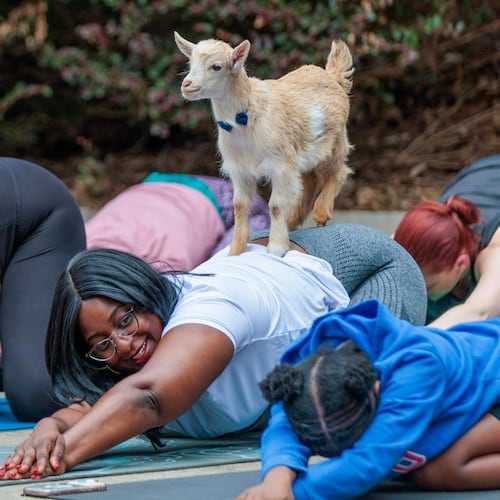Bill York was browsing through the items strewn on a yard-sale table almost a decade ago when he saw it peeking out from a pile of unwanted junk. Squished amid the detritus of another life was a Purple Heart, the military decoration given to those wounded or killed in battle.
The World War II Navy veteran was appalled that the symbol of the country’s oldest honor was reduced to no more than a collectible with a $5 price tag.
“The woman selling it said it belonged to a boarder who had taken off, and she had found it under his bed,” York said. “I told her to call the guy to come get it or I’d buy it.”
The seller took the item away, but the encounter left York perturbed. He went home to Tucker and dug out a box of memorabilia from his brother Johnny, a young World War II paratrooper of the 101st Airborne Division who was wounded on D-Day and died during the Battle of the Bulge, earning two Purple Hearts, a Bronze Star and a wealth of citations.
“I really got thinking,” said York, 84. “I wondered what would happen to these things when I’m gone. Would they wind up in someone’s yard sale, too?”
York found the answer seven years ago. On a trip to a school reunion in Indiana, he stopped at a museum in Fort Campbell, Ky., home of the 101st Airborne -- the "Screaming Eagles" whose exploits were celebrated in the TV miniseries “Band of Brothers.”
As York strolled the exhibits, inspiration hit. He returned home, dug out his brother’s medals and honors, and mounted them in a shadowbox that he donated to the museum. Today, it occupies a prominent piece of wall space in the World War II section.
“It’s in a wonderful location,” said Dot York, who married Bill York 37 years ago. “We have many friends who have gone to see it and have told us how special it is.”
Pleased that his brother’s mementos had become a lasting legacy, York went on with his life. Then last year, he made another discovery, hidden amid an assortment of collectibles in his own living room.
‘Mentor and best friend'
Bill York was born in 1925 on the edge of a farm in a tiny town southwest of Indianapolis. He and his brother Johnny were tykes when their parents split, and the boys, just two years apart, lived with their grandparents.
“Those were fragmented times,” York said. “You either worked or went hungry. My salvation was the imagination of my brother, who was my mentor and best friend.”
The two boys picked blueberries and mushrooms, collected walnuts and hickory nuts, shot squirrels and rabbits, and sold them to schoolteachers (“because they had an income”). When Johnny read about a skin dealer in Terre Haute who was buying pelts, the two hiked 25 miles to meet the dealer, who provided the traps and agreed to pay them 20 to 50 cents a skin. They worked on their new enterprise in the early hours before heading to school, where Johnny was a standout.
“Johnny was so smart, he skipped two grades in elementary school,” York said. “By the time I made it to high school, he had already graduated and moved on.”
The last time the two brothers met was in 1942, when Johnny came by to show off his Army uniform and say goodbye. At 18, he was heading off to be a paratrooper in the 101st Airborne.
“I don’t know why he picked the 101st,” York said. “But then I realized he did have a proclivity for jumping out of something. He was always jumping out of trees, out of the oak tree over the creek where we used to swim. He was very proud of his choice.”
It wasn't long before York followed his brother's lead and enlisted, picking the Navy because "I knew the beds had clean sheets and there was food."
He spent three years in the Mediterranean Sea, sailing around Italy, France and North Africa. He participated in three invasions as a crewman on a 13-man, flat-bottomed boat that delivered supplies. It wasn't until the war was almost over that he learned Johnny had been wounded in the D-Day landings, went back to fighting and was killed on Dec. 19, 1944.
His brother was one month shy of his 21st birthday.
Assignment completed
York learned more about Johnny when he attended a 1947 national convention of the 101st, where he met Gen. Anthony McAuliffe, his brother’s commanding officer, who was famous for replying to a German order to surrender by saying, “Nuts!”
“They all remembered ‘Sergeant York’,” he said, referring to his brother but citing the Gary Cooper movie about the World War I sharpshooter of the same name. “But I don’t know if he suffered, or if he knew death was imminent. And there isn’t a week that goes by that I don’t have fond recollections. I still envy seriously people who have brothers.”
York’s own life has been eventful. During the war, he met famed correspondent Ernie Pyle, who inspired him to study journalism at Butler University in Indianapolis. While in school, he happened upon a fur salon where he knew every pelt in the window. He walked in the door to ask about a job and landed a career in furs that lasted through several major retailers across the country. He opened his own store, York Furs, in Buckhead in 1977 and sold it 14 years later. Since then, he has published six novels and enjoyed retirement with Dot, who once owned an antique store in Lilburn and whose shopping trips brought him to the yard sale where he discovered the abandoned Purple Heart.
Dot's display of collectibles in their living room yielded another treasure.
“There it was -- another Bronze Star that belonged to my brother,” York said, still amazed at the discovery. “I then went online and found a presidential citation for his unit that I hadn’t seen before.”
Later this month, York heads back to Fort Campbell to add the star and citation to his brother’s box. Museum director Dan Peterson welcomes the additional items.
“So much of what we have is donated by veterans,” Peterson said. “We have uniforms, helmets, weapons, one of Hitler’s walking sticks, even the ‘Bastogne’ sign taken from the town in France. We are always happy to accept donations.”
Delivering the last of his brother’s memorabilia closes a chapter, says York, whose voice cracks and eyes water as he remembers the young man he has long outlived. “I feel that this last piece completes the assignment to honor his memory.”
Sidebar: 101st Airborne Museum, Fort Campbell, Ky.
Fort Campbell, about an hour’s drive northwest of Nashville, is home to the 101st Airborne Division and the Don Pratt Museum. In 1956, the museum moved into one of the fort’s former movie houses. Its 14,000 square feet were quickly filled with memorabilia, photos and artifacts that recount the inception of airborne combat during World War II through its service to present day.
Museum director Dan Peterson oversees the collection that includes many personal items donated by veterans, from uniforms to rare artifacts of the Third Reich. The World War II exhibits feature items as delicate as a child’s dress embroidered with parachute silk to a battered helmet.
“We have an American helmet found and returned to us by a Dutch man, and we know that soldier was killed,” Peterson said. “But years later, that soldier’s daughter was able to come here and hold his helmet in her hands.”
Among the most noteworthy pieces brought back from Germany are silver cups that belonged to Hitler henchman Hermann Goering, now inscribed with the names of American officers who captured them; bowls and platters from Hitler’s home; and a Nazi flag torn down in Normandy and photographed as it was held up by American soldiers. One of the rarest items on display is a restored World War II cargo glider that carried soldiers and equipment into battle zones. Peterson says it is one of just four still in existence.
The museum also devotes considerable space to equipment and artifacts from the 101st’s campaigns in Vietnam, Desert Storm and the Gulf War. Across the street is an outdoor collection of military aircraft. A reference library and archives provide information about 101st members. Three times a year, the museum hosts re-enactors who showcase uniforms and weaponry and who often bring their own collectibles.
The museum is open from 9:30 a.m. to 4:30 p.m. Mondays through Saturdays, except for Christmas and New Year’s Day. Admittance to the base requires proof of identification, as well as proof of insurance and registration for any vehicle driven inside the gates. For more information, visit www.fortcampbell.com or call 270-798-3215.
About the Author
Keep Reading
The Latest
Featured

